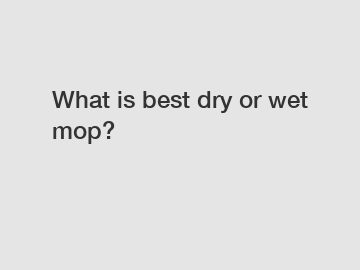What is best dry or wet mop?
What is Best: Dry or Wet Mop?
When it comes to cleaning our floors, we are often faced with the dilemma of choosing the best mop. With so many options available in the market, it's challenging to decide whether a dry or wet mop is the most effective. To help you make the right choice, let's explore the pros and cons of both types.
1. Dry Mopping.

Dry mopping involves using a mop that doesn't require water or any cleaning solution. Instead, it uses static electricity or microfiber technology to trap and lift dirt and debris from the floor. Here are some points to consider:
- Quick and Convenient: Dry mopping is a quick and hassle-free way to remove surface dust, pet hair, and other loose particles from your floors. You can simply grab a dry mop and go, without the need to prepare any cleaning solutions or wait for the floor to dry.
- Safe for Hardwood and Laminate: Dry mopping is particularly suitable for hardwood and laminate floors. These surfaces are prone to damage when exposed to excessive moisture. Using a dry mop ensures your floors stay safe while effectively cleaning them.
- Not Ideal for Sticky Spills: While dry mops are great for regular maintenance, they may not be sufficient for sticky spills or stubborn stains. Dry mops lack the moisture necessary to break down and remove these tough messes.
2. Wet Mopping.
Wet mopping, as the name suggests, involves using a mop that is dampened with water or a cleaning solution. This method is effective in lifting and removing dirt, grime, and stains. Here are some key points about wet mopping:
- Deep Cleansing: Wet mopping provides a more thorough cleaning compared to dry mopping. The moisture helps dissolve dirt and grime, leaving your floors sparkling clean and sanitized. It is particularly useful for tile, linoleum, and vinyl floors, where dirt can accumulate in the grout lines or textured surfaces.
- Effective for Sticky Spills and Stains: Wet mops excel at tackling tough messes like spilled drinks, food stains, or muddy footprints. The moisture helps loosen the dirt, making it easier to remove from the floor.
- Longer Drying Time: Wet mopping requires the use of water or cleaning solutions, which can leave your floors wet. This necessitates a longer drying time, during which you may need to avoid walking on the floor to prevent slips and falls.
- Potential for Damage: While wet mopping is excellent for many floor types, it may not be suitable for hardwood or laminate floors. Excessive moisture can cause warping, cupping, or discoloration. Always check the manufacturer's recommendations before using wet mops on such surfaces.
In conclusion, choosing the best mop depends on your specific needs and the type of floor you have. If you are looking for a quick and convenient way to maintain your floors and remove loose debris, a dry mop is an excellent choice. On the other hand, if you want a deeper cleanse and need to tackle tough spills and stains, a wet mop is more suitable.
Consider the surface you'll be cleaning, the level of dirt and grime, and the potential for damage when deciding between the two. Furthermore, it's worth noting that some mops in the market offer the option to switch between dry and wet modes, providing versatility and making your cleaning routine even more efficient.
So, whether it's a dry mop or a wet mop you ultimately choose, rest assured that both methods can help you maintain clean and beautiful floors in your home or business.
If you are looking for more details, kindly visit wholesale microfiber bath towels, microfiber cleaning towel manufacture, microfiber mop stripe for sale.

Comments
0